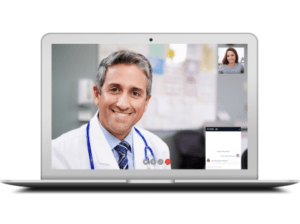 “Telehealth is finally upon us. As someone who has been practicing in this world for several years, I was always waiting for an inflection point,” David Houghton, neurologist and chair of Telehealth and Digital Medicine at Oschner Health (New Orleans, USA), stated during the latest Society of NeuroInterventional Surgery (SNIS) webinar. Alongside Houghton, Johanna Fifi, associate professor of neurology and neurosurgery at Mount Sinai Health System (New York, USA), also presented her experience with the growing use of telemedicine for neurointerventional consults.
“Telehealth is finally upon us. As someone who has been practicing in this world for several years, I was always waiting for an inflection point,” David Houghton, neurologist and chair of Telehealth and Digital Medicine at Oschner Health (New Orleans, USA), stated during the latest Society of NeuroInterventional Surgery (SNIS) webinar. Alongside Houghton, Johanna Fifi, associate professor of neurology and neurosurgery at Mount Sinai Health System (New York, USA), also presented her experience with the growing use of telemedicine for neurointerventional consults.
“We have been hearing about this [telemedicine] for some time, so why has it suddenly required a pandemic to push us over the hill?” Houghton questioned. One theory, he said, is known as Amara’s law, which states: “We tend to overestimate the effect of a technology in the short run, and underestimate the effect in the long run.”
Telemedicine and the hype cycle
Pointing to the curve depicted by the hype cycle, Houghton explained that with any technology, there is an inflated expectation of what it can accomplish, followed by a trough of disillusionment, and finally, once people revisit the technology’s potential, a plateau of productivity.
“If we are positive about this, we can suggest that in the pre-COVID world, we had gone through the peak of inflated expectation [with telemedicine], and in some circumstances, it did not last. Now, we are going through our slope of enlightenment, hoping to end up with a plateau of productivity in a post-COVID world. That ultimately will be a unique state for us to practice, and will revolutionise the way we are able to take care of our patients,” he added.
In contrast, Houghton speculated that a cynic might argue that the pandemic itself is bringing a peak of inflated expectation. “We might find ourselves again in a trough of disillusionment once COVID-19 is over.”
However, Houghton does not believe this will happen. Through utilising the five ‘A’s’: availability, accessibility, affordability, appropriateness, and acceptability, he explained why telemedicine is here to stay.
It is important to offer something that is available, he argued, where a healthcare provider can assess a condition. Alluding to a “significant” supply and demand problem in medicine, as patients find it hard to find available physicians, Houghton said this represents one of the gaps in medicine currently. And if availability is the “when”, accessibility is the “how”, he noted, acknowledging the aspect of cost.
Nevertheless, he said that telemedicine needs to maintain a level of appropriateness. He questioned whether providers and patients will trust the quality of care arising from these novel consultations. “And what will the acceptability be? As we build programmes within our systems, we have to have the foresight to anticipate whether they will be acceptable to our patients.”
Facilitating future digital capabilities
In terms of how telemedicine can apply to the neurointerventional field going forward, Houghton outlined two distinct areas of potential: maintaining active outpatient clinical practices, and to serve as a complementary surgical planning tool, alongside 3D printing, virtual reality, and augmented reality.
“We think that the expanse [of telemedicine] has particular potential for education and research; it is a unique opportunity,” he asserted.

While the use of telemedicine is more recent in New York, Johanna Fifi said that last year, the stroke team at Mount-Sinai decided to begin deploying telemedicine machines. “It became obvious that the in-person consults were not entirely necessary,” she said.
“Since we have a system where we have one comprehensive stroke centre, but several thrombectomy-capable stroke centres, we have now converted to doing ‘tele-rounding’ at some of those sites,” Fifi added. Cameras have been installed into patient’s rooms, she noted, to facilitate doctor and nurse communication, but also for the patients to be able to communicate with their families during this social-distancing environment.
“I personally think that it [telemedicine] will not go away. Some of the patients see the value of being able to do these visits from home.” she argued. However, Fifi highlighted that she wants the technology to advance. “I hope that companies realise that this is a good space to be in so that it becomes competitive and better, user-friendly options get developed.”
During the SNIS webinar, audience members had the opportunity to ask questions. One member asked whether physicians felt as though they were carrying out effective neurological exams via telemedicine. Houghton replied: “It depends on the patient and the requirements for decision making, as well as the breadth and depth of the disease process being evaluated.”
He acknowledged that the National Institutes of Health Stroke Scale (NIHSS) is almost exclusively visual, which means it translates well onto a telestroke network. In contrast, he speculated that no one is comfortable making a diagnosis of ALS (amyotrophic lateral sclerosis) without the ability to tap a reflex to find hyperreflexia. “There are always limitations,” he added.
In agreement, Fifi argued that physicians are limited by what they can see. However, she noted that for the majority of neurointerventional patients, telemedicine is possible. “We are using it now for a lot of patient follow-ups, with the majority of them being asymptomatic.”
Are regulatory changes here to stay?
Alluding to major changes in the USA that support telemedicine, Houghton said the first is reported enforcement discretion of Health Insurance Portability and Accountability Act (HIPAA) violations. “As a system we felt it was very important for us to continue to utilise virtual visits, with what we recognise as HIPAA compliant, and yet, we do also know that there are some other systems that do not have that luxury. So utilising things such as Facetime, Facebook Messenger and Skype—traditionally not thought to be HIPAA compliant—are allowable at this time and available to practitioners.”
“Similarly, licensure requirements for interstate practices have been softened. In many circumstances, the administrator burden has been lessened, with the possibility to activate emergency practice within another state through a simple phone call or email.”
Discussing the importance of these changes, Houghton surmised: “The world has changed with COVID-19. The reality is that the repercussions of it in the medical world are going to be felt for years. We have realised that without the current access to healthcare; the misdiagnoses and the delayed diagnoses; the inability for patients to undergo non-urgent surgeries, there will be a greater demand on the healthcare system.”













